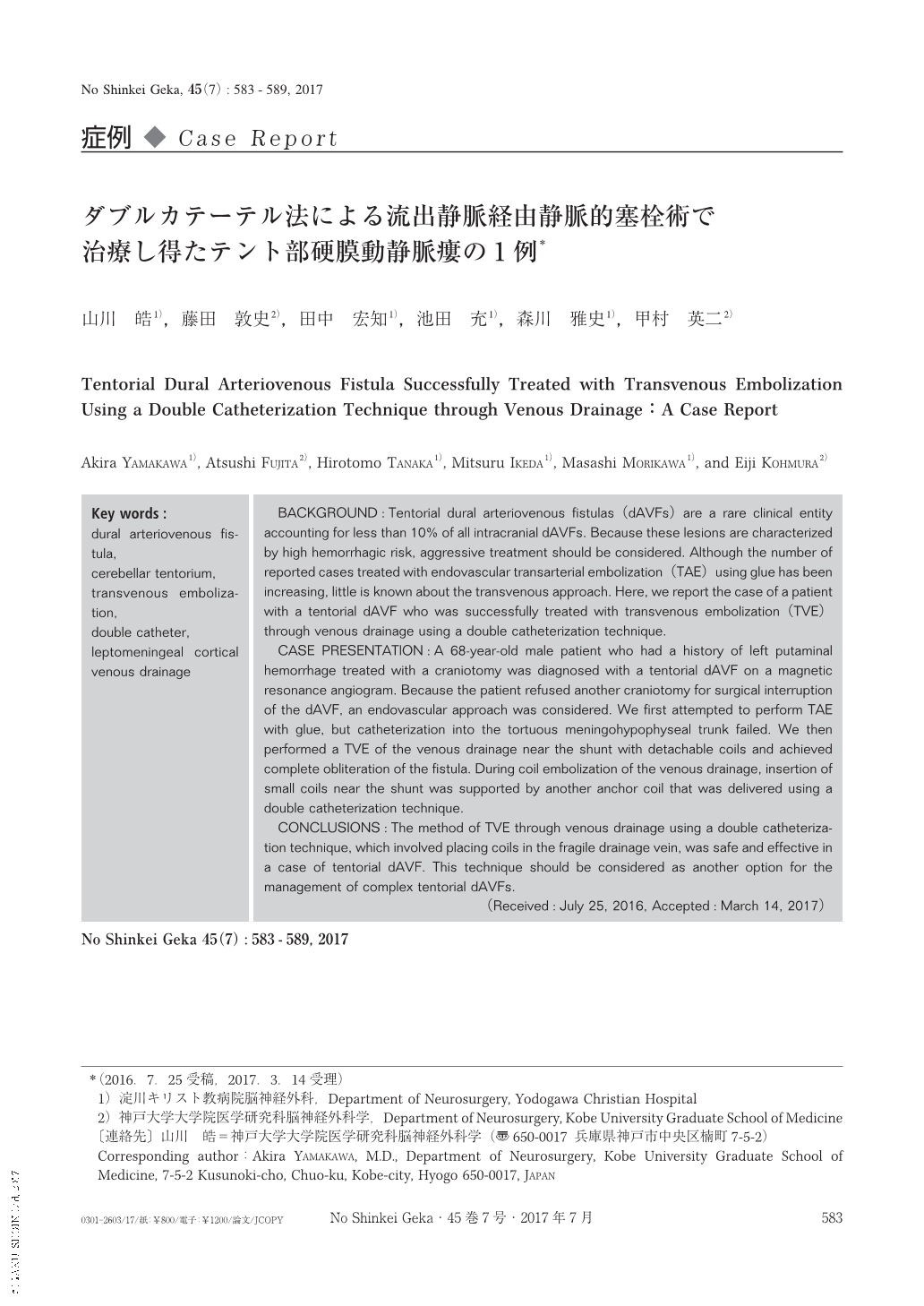Japanese
English
- 有料閲覧
- Abstract 文献概要
- 1ページ目 Look Inside
- 参考文献 Reference
Ⅰ.はじめに
頭蓋内硬膜動静脈瘻(dural arteriovenous fistula:dAVF)は頭蓋内血管奇形の10〜15%を占める稀な疾患であり1,8,11),テント部dAVFは桑山ら10)の報告で頭蓋内dAVFの3.2%,海外の報告1)でも8.4%にすぎない.これらの報告では,同部位のdAVFは高率に出血,静脈性梗塞などを呈する(頻度はそれぞれ67.7%10),96.9%1))とされ,積極的治療を要する.この部位のdAVFは静脈洞を介さずに直接静脈に流出することが多く,古くから開頭による流出静脈離断が確実な治療として報告されている5,12,18).近年では液体塞栓物質を用いた経動脈的塞栓術(transarterial embolization:TAE)の報告が散見され,比較的高い閉塞率が報告されている6,8,9,14,16,20).一方,経静脈的塞栓術(transvenous embolization:TVE)による治療は難しく,報告も少ない.今回われわれは,non-sinus typeテント部dAVFに対し,流出静脈を介したTVEを行うことで根治し得た症例を経験した.これまでにnon-sinus type dAVFに対する流出静脈を介したTVEの報告は数編が散見される程度4,17,20)であり,その適応は限定的である.われわれは,流出静脈のシャントに近い部分に細径コイルを密に留置するために,ダブルカテーテル法を用いて流出路にアンカーコイルを留置する工夫を行うことで,確実な治療を行い得たのでその有用性を報告する.
BACKGROUND:Tentorial dural arteriovenous fistulas(dAVFs)are a rare clinical entity accounting for less than 10% of all intracranial dAVFs. Because these lesions are characterized by high hemorrhagic risk, aggressive treatment should be considered. Although the number of reported cases treated with endovascular transarterial embolization(TAE)using glue has been increasing, little is known about the transvenous approach. Here, we report the case of a patient with a tentorial dAVF who was successfully treated with transvenous embolization(TVE)through venous drainage using a double catheterization technique.
CASE PRESENTATION:A 68-year-old male patient who had a history of left putaminal hemorrhage treated with a craniotomy was diagnosed with a tentorial dAVF on a magnetic resonance angiogram. Because the patient refused another craniotomy for surgical interruption of the dAVF, an endovascular approach was considered. We first attempted to perform TAE with glue, but catheterization into the tortuous meningohypophyseal trunk failed. We then performed a TVE of the venous drainage near the shunt with detachable coils and achieved complete obliteration of the fistula. During coil embolization of the venous drainage, insertion of small coils near the shunt was supported by another anchor coil that was delivered using a double catheterization technique.
CONCLUSIONS:The method of TVE through venous drainage using a double catheterization technique, which involved placing coils in the fragile drainage vein, was safe and effective in a case of tentorial dAVF. This technique should be considered as another option for the management of complex tentorial dAVFs.

Copyright © 2017, Igaku-Shoin Ltd. All rights reserved.


